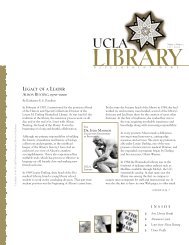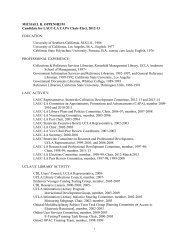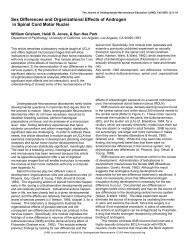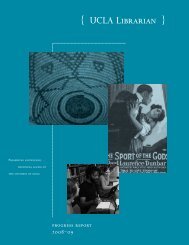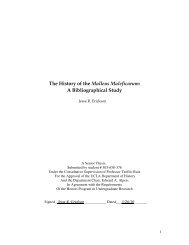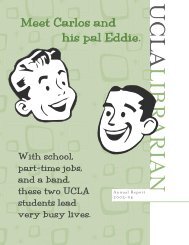Research Paper - UCLA Library
Research Paper - UCLA Library
Research Paper - UCLA Library
Create successful ePaper yourself
Turn your PDF publications into a flip-book with our unique Google optimized e-Paper software.
Gu 22<br />
woman’” (Mullaney 139). In fact, on the evening of Elizabeth’s death, celebrations broke out in<br />
London as people yelled in the streets, “We have a king!” (Mullaney 139). Although Elizabeth’s<br />
historical reputation would later be vindicated as the Jacobean and Caroline courts ran<br />
themselves into destruction (as witnessed by the execution of Charles I in 1649), the immediate<br />
reaction to her death appears to have been relief. Thus, when examining a play written so early<br />
after the ascension of a new king, it seems appropriate to ask exactly whose court is The<br />
Revenger’s Tragedy commenting on.<br />
Again we must turn to The Faerie Queene to clarify the allusive Gloriana’s relationship<br />
to the historical Elizabeth by looking at exactly how Spenser envisioned Gloriana as the “greatest<br />
Glorious Queene of Faerie lond.” In Spenser’s Prefatory Letter to Sir Walter Raleigh, which was<br />
also circulated around the time of The Faerie Queene’s publication, Spenser outlines his<br />
allegorical piece, explaining what important figures were meant to represent and how they<br />
should be read. In describing Gloriana, Spenser writes,<br />
“In that Faery Queene I meane glory in my generall intention, but in my particular<br />
I conceive the most excellent and glorious person of our soveraine the Queene,<br />
and her kingdome in Faery Land. and yet, in some places els, I doe otherwise<br />
shadow her. For considering she beareth two persons, the one of a most royall<br />
queene or empresse, the other of a most vertuous and beautiful lady.” (Spenser<br />
716)<br />
Here Spenser clearly states that the fairy queen is “our soveraine the Queene,” setting up the<br />
connection that Middleton would later exploit. However, what is even more interesting is the<br />
notion that the queen “beareth two persons,” which alludes to the early modern concept of the<br />
king’s two “bodies,” one corporal and mortal, the other abstract and eternal. While each monarch



